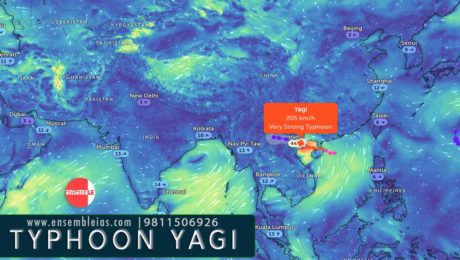#Typhoon #Yagi update. Next stop: #Vietnam
Yagi is back over warm waters in the #Gulf of #Tonkin, which will keep the #typhoon strong.

Destructive #winds up to 200 km/h will lash the northern coast of Vietnam near #Haiphong as the typhoon makes landfall on Saturday.
#typhoon_yagi

September 7, 2024
Typhoon Yagi made landfall in Vietnam’s coastal provinces of Quang Ninh and Haiphong, bringing with it destructive winds gusting up to 149 kilometres per hour. The typhoon caused widespread damage and loss of life, leaving a trail of devastation in its wake.
According to Vietnamese authorities, Typhoon Yagi claimed the lives of at least four individuals and left 78 others injured. Many of the casualties were caused by falling trees, collapsed structures, and flying debris. The typhoon also caused significant damage to homes, businesses, and infrastructure.
In the aftermath of the typhoon, emergency response teams have been deployed to the affected areas to assess the damage and provide assistance to those in need. Rescue workers searched through the rubble of collapsed buildings in search of survivors, while medical personnel provided aid to the injured.
The government of Vietnam mobilized resources to support the relief efforts, including providing food, water, and shelter to those displaced by the typhoon. International aid organizations also stepped in to offer assistance, sending teams of volunteers and supplies to the affected areas.
In the hours following the typhoon, recovery efforts began in earnest. Residents and volunteers worked together to clear debris, repair damaged homes and businesses, and restore essential services. The government also launched a long-term reconstruction plan to rebuild infrastructure and strengthen the resilience of coastal communities to future storms.
Typhoon Yagi, a formidable force of nature, serves as a stark reminder of the catastrophic consequences that natural disasters can inflict upon communities. With its torrential rains, howling winds, and relentless storm surges, Typhoon Yagi left a trail of destruction in its wake, reshaping landscapes and shattering lives.
The typhoon’s fury was indiscriminate, affecting coastal towns and inland villages alike. Homes were reduced to rubble, businesses were decimated, and infrastructure crumbled under the immense pressure of the storm. Entire neighbourhoods were inundated, leaving residents stranded and desperate for assistance. Crops were flattened, wiping out livelihoods and exacerbating food insecurity.
In the aftermath of Typhoon Yagi, communities were left grappling with the immense task of rebuilding. Families struggled to piece together their shattered lives, while emergency responders worked tirelessly to restore essential services and provide aid to those in need. The physical and emotional scars left by the typhoon ran deep, and the healing process would be long and arduous.
Typhoon Yagi’s devastation highlights the urgent need for preparedness and resilience in the face of natural disasters. Governments and organizations must invest in robust infrastructure, early warning systems, and community education programs to mitigate the impact of future storms. By working together, we can build stronger, more resilient communities that can withstand the challenges posed by natural disasters and emerge from them with renewed hope and determination. It also highlighted the importance of preparedness and the need for robust disaster response mechanisms. The lessons learned from Typhoon Yagi will undoubtedly contribute to Vietnam’s efforts to mitigate the risks posed by future storms and build a more resilient society.
Best Online Coaching for Civil Service_IAS_ UPSC_IFS_IPS
Free Study Material ENSEMBLE IAS ACADEMY | Call +91 98115 06926 | Visit us:- https://ensembleias.com/ | Online Store: https://online.ensemble.net.in/
#Gulf, #Tonkin, #typhoon, #typhoon_yagi, #Yagi, #Typhoon Yagi,
Source: zoom.earth



